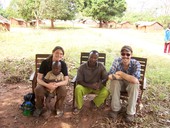Highlight
Congo Basin Rainforest Prehistory Challenged and Extended
Achievement/Results
Dr. Karen Lupo and a team of faculty and graduate student trainees from Washington State University and the University of Washington have discovered several prehistoric anthropogenic impacts on Congo Basin rainforest habitats, such as iron-working and farming, appear much earlier than previously thought. The prehistory of this area is very poorly known because of poor infrastructural development in the Congo Basin, especially in remote forested areas. The Central African rainforest presents a unique opportunity to study how humans interact with each other and the environment, and how technological, socio-political and economic change influences biocultural aspects of hunter-gatherer lifeways. This area is one of the last places on earth where forest hunter-gatherers and peasant farmers maintain relationships to each other and the land that probably originated some 2,000 years ago. This area also contains pockets of endemic plants and animals found nowhere else in the world. Understanding how change impacts this area can help us better understand and predict future human development projects and conservations efforts.
This program is funded in part by the National Science Foundation’s Integrative Graduate Education and Research Traineeship to Washington State University and University of Washington, which allows researchers from diverse backgrounds including biologists, social scientists, paleoecologists and archaeologists to collaborate on this multi-themed and complex project. This collaborative project also involves researchers and students from the Central African Republic, a country that is under-represented in funded research in the sciences and social sciences.
Within the last year our research in this area has focused on collecting and analyzing information on the changing face of parent and child interactions and adult social relationships, the social and physical impacts resulting from the influx of tobacco products, and archaeological and paleoecological information. Team members will present more complete results at the International Conference on Congo Basin Hunter-Gatherers in Montpellier, France in September 2010. This conference is sponsored by Centre National de la Recherche Scientifique (National Center for Scientific Research), Centre d’Ecologie Fonctionnelle et Evolutive (CEFE), L’Institut de Recherche pour le Développement (IRD), University of Toyama, Faculty of Humanities, Department of Cultural Anthropology (Japan), and Washington State University. With funding from NSF, this conference will bring together scholars and researchers from around the world to share information and project results.
Address Goals
Given the high numbers of indigenous species in the rainforest, and their very important role in carbon sequestration, the conservation into the future of the world’s remaining rainforests is of global concern. It is therefore important to know something about humans have used these biomes over the very long term, and yet their prehistory is extremely poorly known. Understanding the stability of the forager-farmer relationship in the rainforest, for example, requires that we know something about how long this relationship has existed, and the environmental impacts of various ways on the rainforest of various ways of making a living. Our research contributes to this goal, and also reaches out to scientists and students in the Central African Republic to help them to participate in and benefit from the international interest in their region’s ecology and prehistory.







